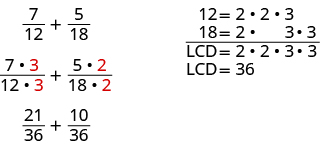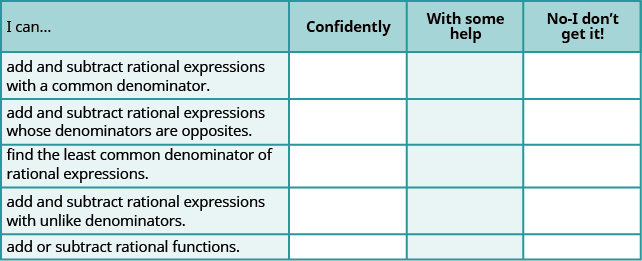
By the end of this section, you will be able to:
Before you get started, take this readiness quiz.
What is the first step you take when you add numerical fractions? You check if they have a common denominator. If they do, you add the numerators and place the sum over the common denominator. If they do not have a common denominator, you find one before you add.
It is the same with rational expressions. To add rational expressions, they must have a common denominator. When the denominators are the same, you add the numerators and place the sum over the common denominator.
If p, q, and r are polynomials where
then
To add or subtract rational expressions with a common denominator, add or subtract the numerators and place the result over the common denominator.
We always simplify rational expressions. Be sure to factor, if possible, after you subtract the numerators so you can identify any common factors.
Remember, too, we do not allow values that would make the denominator zero. What value of x should be excluded in the next example?
Add:
Since the denominator is
we must exclude the value
The expression simplifies to
but the original expression had a denominator of
so
Simplify:
Simplify:
To subtract rational expressions, they must also have a common denominator. When the denominators are the same, you subtract the numerators and place the difference over the common denominator. Be careful of the signs when you subtract a binomial or trinomial.
Subtract:
Subtract:
Subtract:
When the denominators of two rational expressions are opposites, it is easy to get a common denominator. We just have to multiply one of the fractions by
Let’s see how this works.
 |
|
| {: valign=”top”} | Multiply the second fraction by |
|  |
{: valign=”top”}| The denominators are the same. |
|
{: valign=”top”}| The denominators are the same. |  |
{: valign=”top”}| Simplify. |
|
{: valign=”top”}| Simplify. |  |
{: valign=”top”}{: .unnumbered .unstyled summary=”7 divided by d plus 5 divided by negative d. Multiply 5 divided by d times the fraction, negative 1 over negative 1. The result is 7 divided by d plus the quantity negative 1 times 5 all divided by the quantity negative 1times negative d. Notice that the denominators are the same. The denominators are d. 7 divided by d plus negative 5 divided by d. Simplify by adding the numerators. The result is 2 divided by d.” data-label=””}
|
{: valign=”top”}{: .unnumbered .unstyled summary=”7 divided by d plus 5 divided by negative d. Multiply 5 divided by d times the fraction, negative 1 over negative 1. The result is 7 divided by d plus the quantity negative 1 times 5 all divided by the quantity negative 1times negative d. Notice that the denominators are the same. The denominators are d. 7 divided by d plus negative 5 divided by d. Simplify by adding the numerators. The result is 2 divided by d.” data-label=””}
Be careful with the signs as you work with the opposites when the fractions are being subtracted.
Subtract:
 |
|
| The denominators are opposites, so multiply the second fraction by |
 |
| Simplify the second fraction. |  |
| The denominators are the same. Subtract the numerators. |  |
| Distribute. |  |
| Combine like terms. |  |
| Factor the numerator and denominator. |  |
| Simplify by removing common factors. |  |
| Simplify. |  |
Subtract:
Subtract:
When we add or subtract rational expressions with unlike denominators, we will need to get common denominators. If we review the procedure we used with numerical fractions, we will know what to do with rational expressions.
Let’s look at this example:
Since the denominators are not the same, the first step was to find the least common denominator (LCD).
To find the LCD of the fractions, we factored 12 and 18 into primes, lining up any common primes in columns. Then we “brought down” one prime from each column. Finally, we multiplied the factors to find the LCD.
When we add numerical fractions, once we found the LCD, we rewrote each fraction as an equivalent fraction with the LCD by multiplying the numerator and denominator by the same number. We are now ready to add.
 We do the same thing for rational expressions. However, we leave the LCD in factored form.
We do the same thing for rational expressions. However, we leave the LCD in factored form.
Remember, we always exclude values that would make the denominator zero. What values of
should we exclude in this next example?
ⓐ Find the LCD for the expressions
and ⓑ rewrite them as equivalent rational expressions with the lowest common denominator.
ⓐ
| Find the LCD for | |
| Factor each denominator completely, lining up common factors. Bring down the columns. |
 |
| Write the LCD as the product of the factors. |  |
ⓑ
 |
|
| Factor each denominator. |  |
| Multiply each denominator by the ‘missing’ LCD factor and multiply each numerator by the same factor. |
 |
| Simplify the numerators. |  |
ⓐ Find the LCD for the expressions
ⓑ rewrite them as equivalent rational expressions with the lowest common denominator.
ⓐ
ⓑ
,* * *
ⓐ Find the LCD for the expressions
ⓑ rewrite them as equivalent rational expressions with the lowest common denominator.
ⓐ
ⓑ
,* * *
Now we have all the steps we need to add or subtract rational expressions with unlike denominators.
Add:
Add:
Add:
The steps used to add rational expressions are summarized here.
Avoid the temptation to simplify too soon. In the example above, we must leave the first rational expression as
to be able to add it to
Simplify only after you have combined the numerators.
Add:
 |
|
| Do the expressions have a common denominator? | No. |
| Rewrite each expression with the LCD. | |
| Rewrite each rational expression as an equivalent rational expression with the LCD. |
 |
| Simplify the numerators. |  |
| Add the rational expressions. |  |
| Simplify the numerator. |  |
| The numerator is prime, so there are no common factors. |
Add:
Add:
The process we use to subtract rational expressions with different denominators is the same as for addition. We just have to be very careful of the signs when subtracting the numerators.
Subtract:
 |
|
| Do the expressions have a common denominator? | No. |
| Rewrite each expression with the LCD. | |
| Rewrite each rational expression as an equivalent rational expression with the LCD. |
 |
| Simplify the numerators. |  |
| Subtract the rational expressions. |  |
| Simplify the numerator. |  |
| Factor the numerator to look for common factors. |  |
| Remove common factors |  |
| Simplify. |  |
Subtract:
Subtract:
There are lots of negative signs in the next example. Be extra careful.
Subtract:
 |
|
| Factor the denominator. |  |
| Since and are opposites, we will multiply the second rational expression by |
 |
 |
 |
| Simplify. Remember, |  |
| Do the rational expressions have a common denominator? No. |
|
| Rewrite each rational expression as an equivalent rational expression with the LCD. |
 |
| Simplify the numerators. |  |
| Add the rational expressions. |  |
| Simplify the numerator. |  |
| Factor the numerator to look for common factors. |  |
| Simplify. |  |
Subtract :
Subtract:
Things can get very messy when both fractions must be multiplied by a binomial to get the common denominator.
Subtract:
 |
|
| Factor the denominators. |  |
| Do the rational expressions have a common denominator? No. |
|
| Rewrite each rational expression as an equivalent rational expression with the LCD. |
 |
| Simplify the numerators. |  |
| Subtract the rational expressions. |  |
| Simplify the numerator. |  |
 |
|
| Look for common factors. |  |
| Simplify. |  |
Subtract:
Subtract:
We follow the same steps as before to find the LCD when we have more than two rational expressions. In the next example, we will start by factoring all three denominators to find their LCD.
Simplify:
 |
|
| Do the expressions have a common denominator? No. Rewrite each expression with the LCD. |
|
| Rewrite each rational expression as an equivalent rational expression with the LCD. |
 |
 |
|
| Write as one rational expression. |  |
| Simplify. |  |
| Factor the numerator, and remove common factors. |
 |
| Simplify. |  |
Simplify:
Simplify:
To add or subtract rational functions, we use the same techniques we used to add or subtract polynomial functions.
Find
where
and
 |
|
| Substitute in the functions |  |
| Factor the denominators. |  |
| Do the expressions have a common denominator? No. Rewrite each expression with the LCD. |
|
| Rewrite each rational expression as an equivalent rational expression with the LCD. |
 |
| Write as one rational expression. |  |
| Simplify. |  |
 |
|
| Factor the numerator, and remove common factors. |
 |
| Simplify. |  |
Find
where
and
Find
where
and
Access this online resource for additional instruction and practice with adding and subtracting rational expressions.
If p, q, and r are polynomials where
then
and
Add and Subtract Rational Expressions with a Common Denominator
In the following exercises, add.
In the following exercises, subtract.
Add and Subtract Rational Expressions whose Denominators are Opposites
In the following exercises, add or subtract.
Find the Least Common Denominator of Rational Expressions
In the following exercises, ⓐ find the LCD for the given rational expressions ⓑ rewrite them as equivalent rational expressions with the lowest common denominator.
ⓐ
ⓑ
,* * *
ⓐ
ⓑ
,* * *
ⓐ
ⓑ
,* * *
ⓐ
ⓑ
,* * *
Add and Subtract Rational Expressions with Unlike Denominators
In the following exercises, perform the indicated operations.
Add and Subtract Rational Functions
In the following exercises, find ⓐ
ⓑ
and* * *
ⓐ
ⓑ
and* * *
and* * *
ⓐ
ⓑ
and* * *
Donald thinks that
is
Is Donald correct? Explain.
Answers will vary.
Explain how you find the Least Common Denominator of
and
Felipe thinks
is
ⓐ Choose numerical values for x and y and evaluate
ⓑ Evaluate
for the same values of x and y you used in part ⓐ.* * *
ⓒ Explain why Felipe is wrong.* * *
ⓓ Find the correct expression for
ⓐ Answers will vary.* * *
ⓑ Answers will vary.* * *
ⓒ Answers will vary.* * *
ⓓ
Simplify the expression
and explain all your steps.
ⓐ After completing the exercises, use this checklist to evaluate your mastery of the objectives of this section.
 ⓑ After reviewing this checklist, what will you do to become confident for all objectives?
ⓑ After reviewing this checklist, what will you do to become confident for all objectives?

You can also download for free at http://cnx.org/contents/02776133-d49d-49cb-bfaa-67c7f61b25a1@4.13
Attribution: